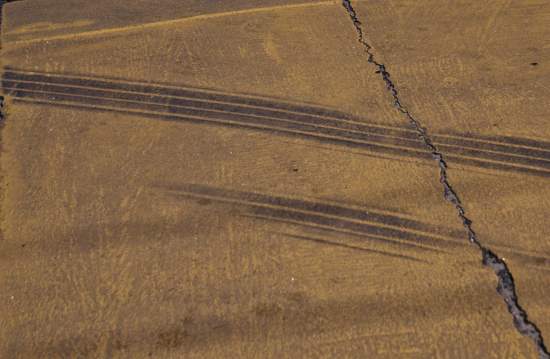Back in the day if you slammed on your brakes your wheels would lock up causing a skid. Once you’re skidding you have no control over your vehicle. Today we see far fewer skid marks on the roads and that’s because of anti-lock braking.
What is a skid?
A skid is where a wheel stops rotating in the same direction that the vehicle is moving and instead slides on the surface.
A skid can either be caused by too much braking or by the vehicle wanting to move sideways through turning (i.e. a wheel can’t rotate sideways). Of course, when a wheel is skidding it then doesn’t work in changing the direction of the vehicle: it becomes impossible to steer.
Friction keeps the wheel rotating against the braking or cornering forces, but if they are too great then the wheel overcomes the friction and a skid happens. The more grippy the surface (i.e. the more friction it has) the louder the skid (in general), therefore a skid on black ice where there’s almost no friction makes almost no sound, whereas a skid on abrasive tarmac makes a loud squeal.

The noise is because energy created in slowing the vehicle down is converted to heat and sound. You hear the skid, and the heat melts the surface layer of rubber onto the road, which is why skid marks create long black lines. Because the tyre is riding on a layer of melted rubber, it takes longer for the vehicle to stop than it would do if it wasn’t skidding but was kept at the point of skidding, which is where ABS comes in.
What is ABS or anti-lock braking system?
ABS stops a wheel from locking using a system of sensors and valves which reduce braking pressure to keep the wheel at the point where it’s about to stop rotating.
ABS only works on the rotation of the wheel as the vehicle moves forwards or backwards, and it doesn’t stop a vehicle from sliding sideways – that’s done using electronic stability control which is a different system.
Because the maximum braking effect happens right at the point where the wheel is almost locking, ABS reduces the overall stopping distance.
Before ABS was invented, drivers used to use cadence braking which is where they would try to feel the point at which the wheels were about to lock up, and modulate (adjust) the brake pedal to try to maintain maximum braking. This was OK for racing drivers and people who could anticipate when they needed to brake, but not so good in an emergency situation on irregular road surfaces when the vehicle’s being driven by an average driver. There would always be some inefficiency: either not braking as hard as is possible, or braking too hard and causing a skid.
ABS allows a driver to slam on the brakes with full force and let the electronics sort out exactly how and where to apply the braking pressure.
How does an anti-lock braking system stop a skid?
Each wheel has a sensor connected to a central controller which monitors the sensors a number of times a second. The central controller knows the usual braking parameters: roughly how fast the wheel can decelerate at a given speed, for example. If it breaks the rules by stopping or slowing down too quickly the central controller realises this and activates a series of hydraulic valves which very quickly reduce the brake pressure allowing the wheel to turn again. This happens in a fraction of a second, and the brake is reactivated immediately. This process can happen once or multiple times, and it is the rapid on/off of ABS that produces the characteristic buzz when it’s activated.
This video explains how ABS works.
Advantages of ABS
- Even inexperienced drivers can apply the maximum braking power
- On mixed surfaces where one or two wheels would lock far earlier than the other wheels it allows for the braking to be distributed for the best effect (this is called electronic brake-force distribution)
- Overall stopping distances are shortened meaning less risk of accidents
- Steering ability is retained while braking
ABS has been compulsory on new cars sold in the European Union since 2004, and more and some countries are moving to make ABS mandatory on motorbikes
Disadvantages of ABS
ABS is another system that can go wrong and that adds weight in a vehicle (although it’s not a part that commonly breaks)
ABS doesn’t work that effectively on very loose gravel, ice or deep snow, but when coupled with electronic stability control (ESC) control can still be maintained.
What are the limitations of ABS?
A tyre only has a certain amount of grip on the road; ABS can’t increase this, it simply uses the maximum grip available.
In some situations, such as deep gravel, it can be quicker to stop if the wheels lock up and dig into the gravel.
Learning how to use ABS
You will feel a vibration through the brake pedal when ABS activates, and if you’ve never felt this before you might think something is wrong and you’ll take your foot off the brake which then defeats the purpose. If you’re driving a car with ABS for the first time, find a quiet stretch of straight road and build up some speed – start at 50kph because you’ll stop quite quickly from this speed. Give yourself some margin on the left-hand side, now slam on the brakes. The pedal will probably go to the floor and you’ll feel the vibration. Steer in a straight line until you come to a stop.
Now try at progressively higher speeds up to 100kph, but be mindful to not do it repeatedly without allowing your brakes to cool down.
ABS on other vehicles
ABS is becoming increasingly common on motorbikes and is already common on new trucks. Some trailers have ABS, too.

